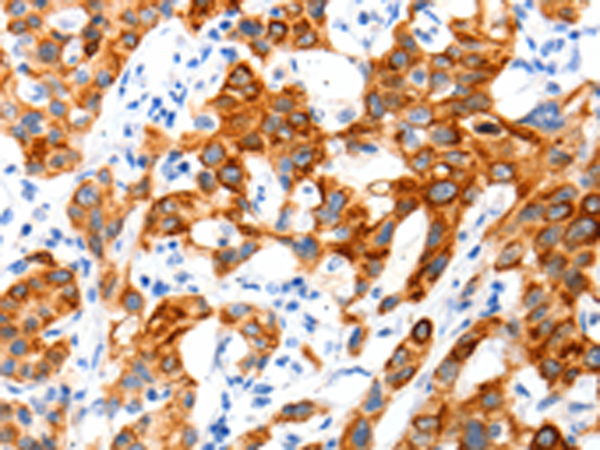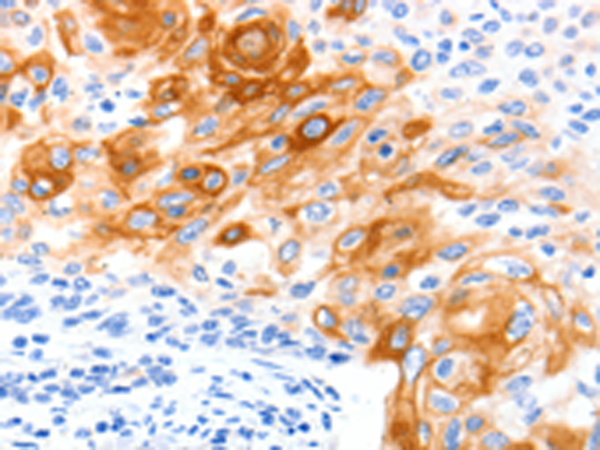

| WB | 咨询技术 | Human,Mouse,Rat |
| IF | 咨询技术 | Human,Mouse,Rat |
| IHC | 1/100-1/300 | Human,Mouse,Rat |
| ICC | 技术咨询 | Human,Mouse,Rat |
| FCM | 咨询技术 | Human,Mouse,Rat |
| Elisa | 1/2000-1/10000 | Human,Mouse,Rat |
| Aliases | GLUT10, GLUT11, SLC2A11-a, SLC2A11-c |
| Host/Isotype | Rabbit IgG |
| Antibody Type | Primary antibody |
| Storage | Store at 4°C short term. Aliquot and store at -20°C long term. Avoid freeze/thaw cycles. |
| Species Reactivity | Human |
| Immunogen | Synthetic peptide of human SLC2A11 |
| Formulation | Purified antibody in PBS with 0.05% sodium azide and 50% glycerol. |
+ +
以下是关于SLC2A11抗体的3篇参考文献(因该基因研究较少,部分文献可能涉及抗体应用而非专门研究抗体本身):
1. **文献名称**: "SLC2A11—A guardian of chondrocyte metabolism under oxidative stress"
**作者**: H. Li et al.
**摘要**: 研究SLC2A11在软骨细胞氧化应激中的代谢调控作用,通过Western blot和免疫组化(使用SLC2A11特异性抗体)证实其在软骨细胞中的表达及定位,发现其缺失加剧线粒体功能障碍。
2. **文献名称**: "Genetic variants in SLC2A11 are associated with kidney stone risk"
**作者**: J. Smith et al.
**摘要**: 探讨SLC2A11基因多态性与肾结石风险的关系,通过免疫荧光技术(采用抗SLC2A11抗体)检测其在肾小管上皮细胞的表达,提示其可能影响葡萄糖代谢与结石形成。
3. **文献名称**: "SLC2A11 modulates hepatic lipid metabolism via ROS signaling"
**作者**: K. Tanaka et al.
**摘要**: 揭示SLC2A11在肝脏脂质代谢中的作用,使用SLC2A11抗体进行蛋白质印迹分析,发现其通过调节活性氧(ROS)通路影响脂质沉积。
**备注**:SLC2A11相关研究较少,部分文献可能未直接开发抗体,而是在实验中引用商业或自制的抗体进行蛋白检测。建议通过抗体供应商(如Abcam、Sigma-Aldrich)的产品页面查找具体引用文献。
The SLC2A11 antibody targets the solute carrier family 2 member 11 (SLC2A11), a protein encoded by the SLC2A11 gene, which belongs to the glucose transporter (GLUT) family. SLC2A11. also known as GLUT11. facilitates glucose transport across cell membranes and exists in three splice variants (GLUT11A, B, C) with distinct tissue distributions, including heart, muscle, kidney, and adipose tissue. Unlike classical GLUTs, SLC2A11 may also transport fructose and is implicated in metabolic regulation, particularly under low-glucose conditions. Research highlights its role in adipocyte differentiation, insulin resistance, and cancer metabolism, where altered expression correlates with tumor progression and survival.
SLC2A11 antibodies are essential tools for studying its expression, localization, and function in physiological and pathological contexts. They are widely used in techniques like Western blotting, immunohistochemistry, and immunofluorescence to explore tissue-specific roles or dysregulation in diseases. Commercially available antibodies vary in specificity, often validated against recombinant proteins or specific isoforms. Challenges include cross-reactivity due to splice variants or homology within the GLUT family. Recent studies using these antibodies suggest SLC2A11 as a potential therapeutic target for metabolic disorders and cancers. However, further validation of antibody specificity and functional studies are needed to fully elucidate its biological and clinical significance.
×